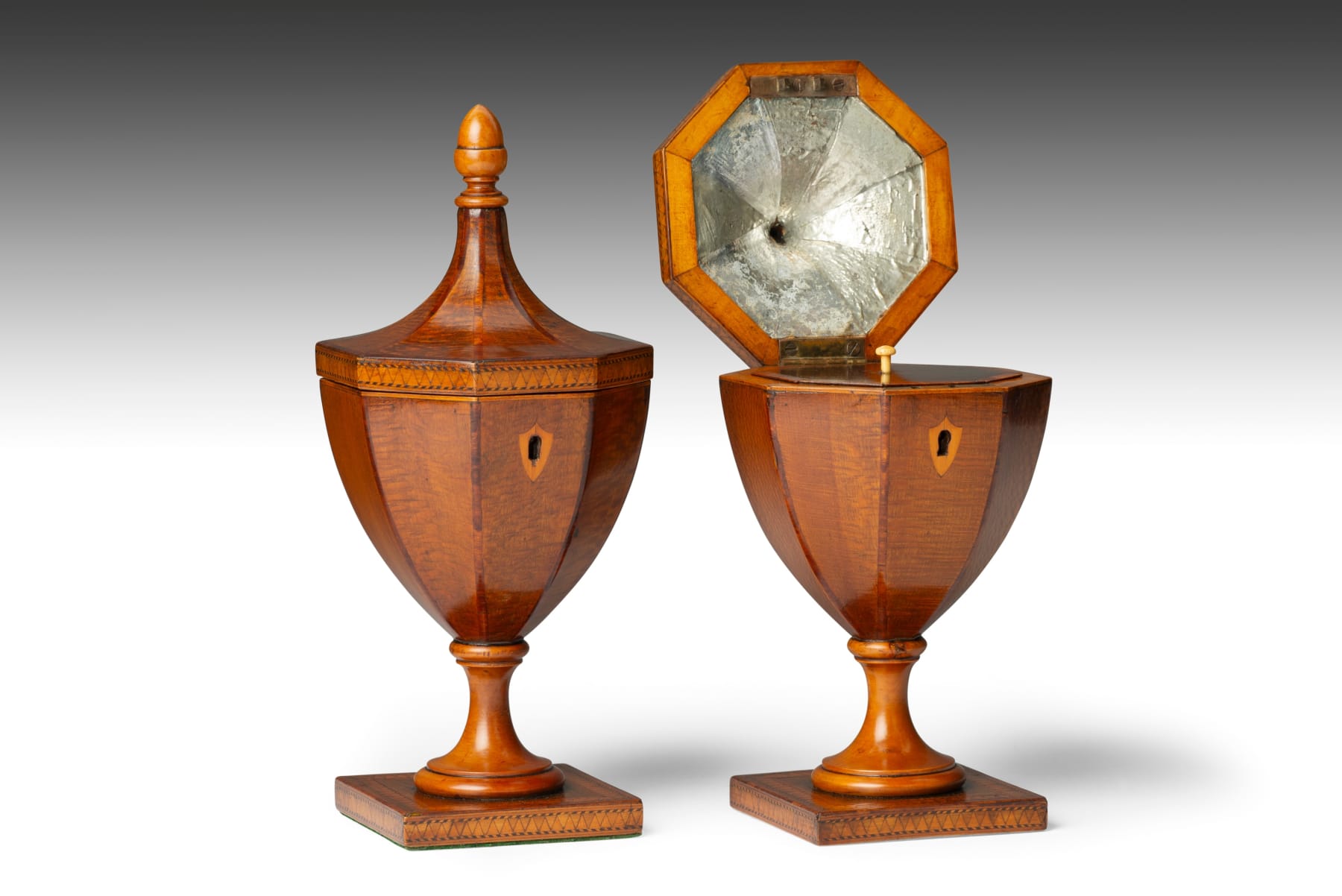Pair of George III Neoclassical Tea Caddies
9 ¾ x 4 ¼ x 4 ¼ in
Further images
Provenance
Ex. Anthony McGrey CollectionLiterature
Anne Stevens, Kate Richenburg, Gillian Walkling (general editors), ‘The Story of British Tea Chests - Social History and Decorative Techniques’ (ACC Art Books, 2022), p. 43, Fig. 2.15
In the form of octagonal lidded urns, the tapering bodies of London plane lacewood, each with a boxwood acorn finial, the hinged lids with crossbanded kingwood decoration and a geometric frieze, opening to reveal a foil lined interior and lift-off lid with a bone knob, the front with an inlaid boxwood shield shape escutcheon, with key. Raised on a turned box wood stem and 8.5cm square base with geometric decoration.
The pair is illustrated in ‘The Story of British Tea Chests and Caddies – Social History and Decorative Techniques’, Anne Stevens, Kate Richenburg and Gillian Walkling (ACC Art Books, 2022, p. 43, fig. 2.15). Discussing the construction of such caddies compared to simpler oval forms, the authors state that ‘Urn-shaped caddies required a similar, but more complex, method of construction, where each shaped ‘stave’ had to be veneered separately.’ (ibid. p. 100). A related mahogany and satinwood tea caddy sold from the Harman Collection, Sotheby’s London, 12 November 1999, lot 3 (illustrated ibid. p. 100 fig. 5.22).
In England in the 1700s tea-drinking was a ceremony. Tea was an expensive commodity during the late seventeenth and early eighteenth centuries, as were the accoutrements relating to its consumption. To keep it safe, the valuable tea leaves would be stored in a ‘tea chest’ which was normally kept locked. Tania M. Buckrell Pos commented that: ‘[b]y the mid-eighteenth century tea chests were being replaced by the all-wooden tea caddy’ and that: ‘[t]he use of contrasting colored woods gave caddies depth and dimension, adding visual appeal to each work’ (Tania M. Buckrell Pos, ‘Tea Caddies’ in ‘Tea & Taste: The Visual Language of Tea’ (Schiffer Publishing, 2004), p.127).
Buckrell Pos continues: ‘It was not until the second half of the eighteenth century that tea caddies became furnishings in their own right’ (ibid, p.129). Designers such as Thomas Chippendale, George Hepplewhite, Robert Adam and Thomas Sheraton offered tea caddies, which enabled them to demonstrate their skills, designs, shapes and woods to potential clients. She observes that: ‘[t]his designer involvement accelerated the popularity of wooden tea caddies and set a high standard for others to follow’. Buckrell Pos comments that tea drinking was fashionable and still very expensive, therefore requiring proper storage in order to ensure its preservation – the tin lining on this pair of caddies would have aided the preservation of the leaves. She remarks that caddies, whilst varying in shape, remained small in size – usually between 3-7 inches wide (ibid, p.129).
Ralph Edwards explains that the word ‘caddy’ is a corruption of ‘catty (Kati)’ – a measurement of weight used in Indonesia and China (‘The Dictionary of English Furniture: Volume Three’ (Antique Collectors’ Club, 1983), p.339).






